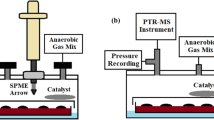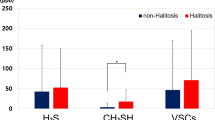Abstract
The development of a breath test by the identification of volatile organic compounds (VOCs) emitted by cariogenic bacteria is a promising approach for caries risk assessment and early caries detection. The aim of the present study was to investigate the volatile profiles of three major cariogenic bacteria and to assess whether the obtained signatures were species-specific. Therefore, the headspaces above cultures of Streptococcus mutans, Lactobacillus salivarius and Propionibacterium acidifaciens were analysed after 24 and 48 h of cultivation using gas chromatography and mass spectrometry. A volatile database was queried for the obtained VOC profiles. Sixty-four compounds were detected within the analysed culture headspaces and were absent (36) or at least only present in minor amounts (28) in the control headspace. For S. mutans 18, for L. salivarius three and for P. acidifaciens five compounds were found to be unique signature VOCs. Database matching revealed that the identified signatures of all bacteria were unique. Furthermore, 13 of the 64 detected substances have not been previously reported to be emitted by bacteria or fungi. Specific VOC signatures were found in all the investigated bacteria cultures. The obtained results encourage further research to investigate the transferability to in vivo conditions towards the development of a breath test.



Similar content being viewed by others
References
Osborne JW, Summitt JB (1998) Extension for prevention: is it relevant today? Am J Dent 11(4):189–196
Peters MC, McLean ME (2001) Minimally invasive operative care. I. Minimal intervention and concepts for minimally invasive cavity preparations. J Adhes Dent 3(1):7–16
Ismail AI, Sohn W, Tellez M, Amaya A, Sen A, Hasson H, Pitts NB (2007) The International Caries Detection and Assessment System (ICDAS): an integrated system for measuring dental caries. Community Dent Oral Epidemiol 35(3):170–178
Meyer-Lueckel H, Bitter K, Paris S (2012) Randomized controlled clinical trial on proximal caries infiltration: three-year follow-up. Caries Res 46(6):544–548
Mejàre I, Axelsson S, Dahlén G, Espelid I, Norlund A, Tranæus S, Twetman S (2014) Caries risk assessment. A systematic review. Acta Odontol Scand 72(2):81–91
Poole DF, Newman HN (1971) Dental plaque and oral health. Nature 234(5328):329–331
Wolff D, Frese C, Maier-Kraus T, Krueger T, Wolff B (2013) Bacterial biofilm composition in caries and caries-free subjects. Caries Res 47(1):69–77
Blaser M, Bork P, Fraser C, Knight R, Wang J (2013) The microbiome explored: recent insights and future challenges. Nat Rev Microbiol 11(3):213–217
Tait E, Perry JD, Stanforth SP, Dean JR (2014) Identification of volatile organic compounds produced by bacteria using HS-SPME-GC-MS. J Chromatogr Sci 52(4):363–373
Höckelmann C, Jüttner F (2004) Volatile organic compound (VOC) analysis and sources of limonene, cyclohexanone and straight chain aldehydes in axenic cultures of Calothrix and Plectonema. Water Sci Technol 49(9):47–54
Farag MA, Ryu CM, Sumner LW, Paré PW (2006) GC-MS SPME profiling of rhizobacterial volatiles reveals prospective inducers of growth promotion and induced systemic resistance in plants. Phytochemistry 67(20):2262–2268
Peeters M (1998) Urea breath test: a diagnostic tool in the management of Helicobacter pylori-related gastrointestinal diseases. Acta Gastroenterol Belg 61(3):332–335
Smith AD, Cowan JO, Brassett KP, Herbison GP, Taylor DR (2005) Use of exhaled nitric oxide measurements to guide treatment in chronic asthma. N Engl J Med 352(21):2163–2173
Scott-Thomas A, Epton M, Chambers S (2013) Validating a breath collection and analysis system for the new tuberculosis breath test. J Breath Res 7(3):037108
Lemfack MC, Nickel J, Dunkel M, Preissner R, Piechulla B (2014) mVOC: a database of microbial volatiles. Nucleic Acids Res 42(Database issue):D744–D748
Blom D, Fabbri C, Connor EC, Schiestl FP, Klauser DR, Boller T, Eberl L, Weisskopf L (2011) Production of plant growth modulating volatiles is widespread among rhizosphere bacteria and strongly depends on culture conditions. Environ Microbiol 13(11):3047–3058
Zehm S, Schweinitz S, Würzner R, Colvin HP, Rieder J (2012) Detection of Candida albicans by mass spectrometric fingerprinting. Curr Microbiol 64(3):271–275
Bunge M, Araghipour N, Mikoviny T, Dunkl J, Schnitzhofer R, Hansel A, Schinner F, Wisthaler A, Margesin R, Märk TD (2008) On-line monitoring of microbial volatile metabolites by proton transfer reaction-mass spectrometry. Appl Environ Microbiol 74(7):2179–2186
Hunziker L, Bönisch D, Groenhagen U, Bailly A, Schulz S, Weisskopf L (2015) Pseudomonas strains naturally associated with potato plants produce volatiles with high potential for inhibition of Phytophthora infestans. Appl Environ Microbiol 81(3):821–830
Walsh K, Jones GJ, Dunstan RH (1998) Effect of high irradiance and iron on volatile odour compounds in the cyanobacterium Microcystis aeruginosa. Phytochemistry 49(5):1227–1239
Kawai F (1995) Bacterial degradation of glycol ethers. Appl Microbiol Biotechnol 44(3-4):532–538
Kleemann R, Meckenstock RU (2011) Anaerobic naphthalene degradation by Gram-positive, iron-reducing bacteria. FEMS Microbiol Ecol 78(3):488–496
Kunz DA, Chapman PJ (1981) Catabolism of pseudocumene and 3-ethyltoluene by Pseudomonas putida (arvilla) mt-2: evidence for new functions of the TOL (pWWO) plasmid. J Bacteriol 146(1):179–191
Leahy JG, Tracy KD, Eley MH (2003) Degradation of mixtures of aromatic and chloroaliphatic hydrocarbons by aromatic hydrocarbon-degrading bacteria. FEMS Microbiol Ecol 43(2):271–276
Musat F, Galushko A, Jacob J, Widdel F, Kube M, Reinhardt R, Wilkes H, Schink B, Rabus R (2009) Anaerobic degradation of naphthalene and 2-methylnaphthalene by strains of marine sulfate-reducing bacteria. Environ Microbiol 11(1):209–219
Sikkema J, de Bont JA (1993) Metabolism of tetralin (1,2,3,4-tetrahydronaphthalene) in Corynebacterium sp. strain C125. Appl Environ Microbiol 59(2):567–572
Acknowledgements
The authors would like to thank Mss. Anja and Antje Richter for their most valuable assistance in the laboratory and Janette Nickel for her help with the mVOC database.
Author information
Authors and Affiliations
Corresponding author
Ethics declarations
Conflict of interest
The authors state that they have no affiliations with or involvement in any organisation or entity with any financial interest or non-financial interest in the subject matter or materials discussed in this article.
Rights and permissions
About this article
Cite this article
Hertel, M., Preissner, R., Gillissen, B. et al. Detection of signature volatiles for cariogenic microorganisms. Eur J Clin Microbiol Infect Dis 35, 235–244 (2016). https://doi.org/10.1007/s10096-015-2536-1
Received:
Accepted:
Published:
Issue Date:
DOI: https://doi.org/10.1007/s10096-015-2536-1




